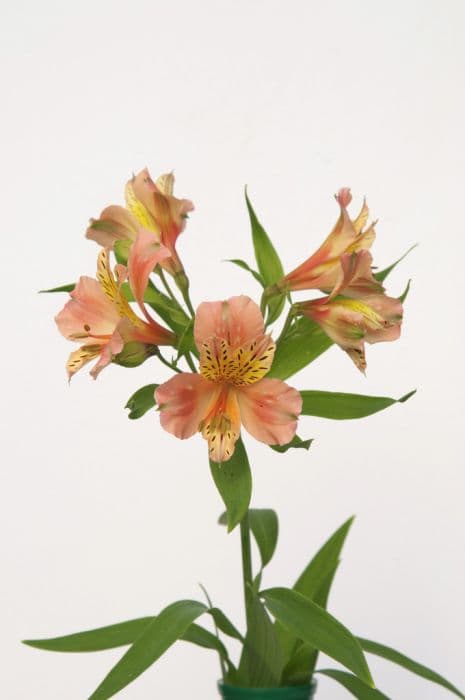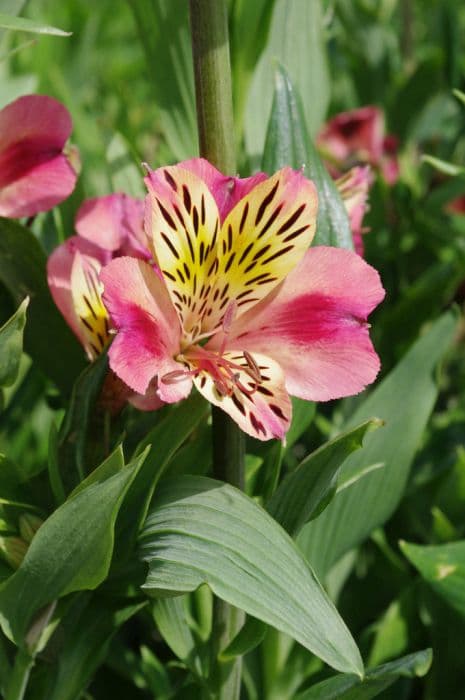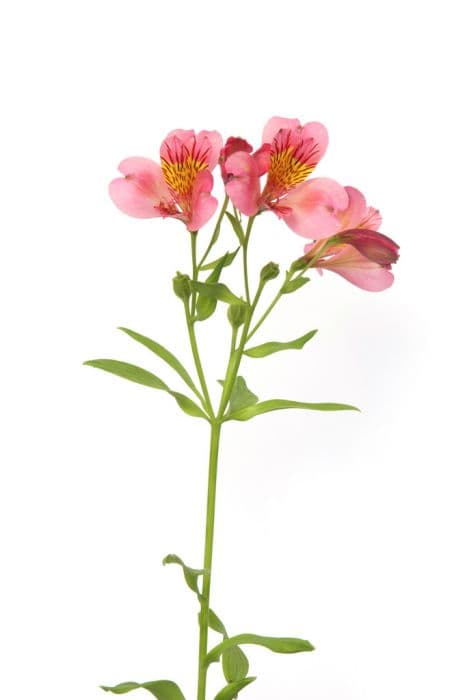Peruvian Lily Alstroemeria 'Spitfire' (v)

ABOUT
The Alstroemeria 'Spitfire', commonly known as the Peruvian Lily or Lily of the Incas 'Spitfire', features a striking display of colors and a dynamic form that makes it a standout in gardens and floral arrangements. Its captivating trumpet-shaped flowers exhibit a bold mix of orange, red, and yellow hues, often with distinctive streaks and speckles decorating each petal, resulting in a fiery appearance that justifies the name 'Spitfire'. Given that its size is not of focus, we can concentrate on its foliage, which consists of lush, green leaves with a slender shape and a linear arrangement along the stems. These leaves may twist and turn, adding an interesting textural element to the overall appearance of the plant. The Peruvian Lily 'Spitfire' is cherished for its vibrant colors, long-lasting blooms, and intricate patterns, which make it a favorite for creating a splash of color in outdoor spaces and as a cut flower in bouquets.
About this plant
 Names
NamesFamily
Alstroemeriaceae.
Synonyms
Peruvian Lily, Lily of the Incas, Parrot Lily.
Common names
Alstroemeria 'Spitfire'
 Toxicity
ToxicityTo humans
The Alstroemeria, commonly known as the Peruvian lily or lily of the Incas, can cause mild toxicity if ingested by humans. Dermatitis can also occur from handling the plant due to the presence of tulipalin, a skin irritant. If ingested, the symptoms of poisoning can include nausea, vomiting, and diarrhea. It is important to avoid consuming this ornamental plant.
To pets
The Peruvian lily is considered mildly toxic to pets such as dogs and cats when ingested. The primary symptoms of poisoning can include vomiting, diarrhea, and mild gastrointestinal upset. While not typically life-threatening, it is advisable to prevent pets from chewing on or ingesting this plant and to consult a veterinarian if consumption occurs.
 Characteristics
CharacteristicsLife cycle
Perennials
Foliage type
Deciduous
Color of leaves
Green
Flower color
Mixed
Height
2-3 feet (60-90 cm)
Spread
1-2 feet (30-60 cm)
Plant type
Herb
Hardiness zones
7
Native area
South America
Benefits
 General Benefits
General Benefits- Vivid Color Display: 'Spitfire' produces striking flowers, typically featuring vibrant reds and oranges that add a splash of color to gardens and floral arrangements.
- Long Bloom Season: Known for its extended flowering period, it ensures a vibrant display throughout much of the growing season.
- Attracts Pollinators: The striking flowers are a magnet for pollinators such as bees, butterflies, and hummingbirds, supporting local ecosystems.
- Cut Flower Excellence: Alstroemeria 'Spitfire' is prized for cut flowers due to its longevity in vases, making it a staple in floral arrangements and bouquets.
- Drought Tolerance: Once established, 'Spitfire' has a degree of drought resistance, making it suitable for water-conscious landscapes.
- Easy Propagation: It can be readily propagated by division, allowing gardeners to easily multiply their plants and share with others.
- Versatile Landscaping: Suitable for borders, containers, and as a bedding plant, 'Spitfire' offers great versatility in its use throughout various garden designs.
- Low Maintenance: Generally resistant to pests and diseases, it requires minimal care beyond regular watering and occasional feeding.
 Medical Properties
Medical PropertiesThis plant is not used for medical purposes.
 Air-purifying Qualities
Air-purifying QualitiesThis plant is not specifically known for air purifying qualities.
 Other Uses
Other Uses- Alstroemeria 'Spitfire' flowers can be used for dye extraction, providing colors for textiles and crafts due to their rich pigmentation.
- The sturdy stems of the plant may be repurposed as natural supports for other plants in a garden arrangement.
- Dried Alstroemeria petals can be incorporated into homemade paper, adding a decorative floral touch to the finished product.
- The blooms are suitable for floating in water features or shallow bowls as a decorative element during events or in home décor.
- Used in the culinary realm, crystallized Alstroemeria petals can adorn desserts or drinks for an edible garnish.
- Plant enthusiasts might cultivate Alstroemeria 'Spitfire' for hybridization purposes, aiming to produce new varieties with unique colors or patterns.
- The flowers can be pressed and used in botanical art works, preserving their beauty in a more permanent form.
- Alstroemeria foliage can serve as a filler in creating natural, eco-friendly packing material for shipping delicate items.
- When hosting educational activities or nature crafts, the different parts of the Alstroemeria can be used to teach botany and plant life cycles.
- The flowers can be used as a natural confetti at celebrations like weddings, providing a biodegradable alternative to traditional paper confetti.
Interesting Facts
 Feng Shui
Feng ShuiThe Peruvian Lily is not used in Feng Shui practice.
 Zodiac Sign Compitability
Zodiac Sign CompitabilityThe Peruvian Lily is not used in astrology practice.
 Plant Symbolism
Plant Symbolism- Friendship: Alstroemeria, commonly known as Peruvian Lily or Lily of the Incas, is often associated with strong bonds of friendship due to its intricate patterns and intertwined petals that are reminiscent of a supportive network.
- Devotion: Its long-lasting blooms make it a symbol of the enduring nature of devotion, suggesting a commitment that remains beautiful over time.
- Prosperity: The Peruvian Lily is also seen as a symbol of material and emotional wealth, bringing a message of prosperity to its recipient.
- Achievement: With its eye-catching flowers, the Peruvian Lily may represent achievement and the pride that comes with reaching goals or milestones.
- Mutual Support: The interlinking of its flowers might denote mutual support in a relationship, crossing through challenges and flourishing in unison.
 Water
WaterPeruvian lilies need consistent moisture, but it's essential to avoid overwatering which can lead to root rot. Water the plants thoroughly when the top inch of soil feels dry to the touch, which might be once a week, depending on your local climate and weather conditions. It's best to water deeply, providing about 1 gallon per plant, ensuring that the moisture reaches the root zone. During the growing season in spring and summer, they may need more frequent watering to maintain soil moisture but cut back during the winter months when the plant goes dormant.
 Light
LightPeruvian lily prefers full sun to partial shade. The ideal spot would be where the plant receives direct sunlight for at least 6 hours a day, but is protected during the hottest part of the afternoon in extremely warm climates. Bright, indirect light will ensure the most vibrant blooms, so a position that offers some shelter from the intense midday sun is optimal.
 Temperature
TemperaturePeruvian lilies thrive in temperatures ranging from 65 to 80°F for ideal growth, flowering, and performance. They can survive minimum temperatures down to about 50°F, but they should be protected from frost. They are not tolerant of extreme cold and will not survive in conditions below freezing. The ideal temperature range ensures healthy growth and blooms.
 Pruning
PruningPruning of Peruvian lily should be done to remove spent flower stems and dead foliage to encourage reblooming and maintain plant health. Prune the stem base after flowering, which is typically late spring through fall, to promote new growth. It's not necessary to prune these plants very often, but doing so after a major flush of blooms can be beneficial.
 Cleaning
CleaningAs needed
 Soil
SoilPeruvian Lily 'Spitfire' thrives in fertile, well-draining soil with a pH between 6.0 and 7.0. An ideal soil mixture can be made by combining two parts loam, one part sand or perlite, and one part peat or humus to ensure proper drainage and fertility.
 Repotting
RepottingPeruvian Lily 'Spitfire' should be repotted every 1 to 2 years to refresh the soil and accommodate root growth. Best done in the spring before the growing season.
 Humidity & Misting
Humidity & MistingPeruvian Lily 'Spitfire' prefers moderate to high humidity levels, typically around 40-60%. This plant does well in naturally humid environments or when humidity is increased with the use of humidifiers or trays of water.
 Suitable locations
Suitable locationsIndoor
Provide bright indirect light and keep soil moist.
Outdoor
Full sun to partial shade, protect from strong winds.
Hardiness zone
7-10 USDA
 Life cycle
Life cycleThe life of Alstroemeria 'Spitfire', commonly known as the Peruvian Lily or Lily of the Incas, begins with seed germination, taking place in warm, moist soil conditions, which typically occur in spring. After germination, the plant develops a rosette of leaves and a deep root system. As it matures, the Alstroemeria 'Spitfire' produces tall, upright stems with clusters of funnel-shaped, brightly colored flowers throughout the summer months, which are known for their long vase life and are popular in the cut flower industry. Following the blooming period, the plant sets seed if pollinators such as bees have facilitated cross-pollination. Over the winter months, the Alstroemeria 'Spitfire' dies back to the ground in cooler climates, entering a period of dormancy. With the return of favorable conditions in the next growing season, the plant regenerates from its tuberous roots, continuing its life cycle.
 Propogation
PropogationPropogation time
Spring to Summer
Alstroemeria 'Spitfire', commonly known as Peruvian Lily or Lily of the Incas, is typically propagated by division, which is the most popular method. Propagation is best done in the spring when the plant emerges from dormancy or in the fall as the growing season winds down. To propagate by division, carefully dig up the clump of tubers from the ground, making sure to keep a generous amount of soil around the roots to minimize stress. Gently separate the tubers by hand, ensuring that each division has at least one eye or shoot from which new growth can emerge. Replant these divisions at the same depth they were growing previously, spacing them about 12 to 18 inches (approximately 30 to 45 centimeters) apart to give them room to grow. Water the newly planted divisions thoroughly to help establish them. This method allows the gardener to increase their stock of Alstroemeria 'Spitfire' while maintaining the health and vigor of the parent plant.




![Peruvian lily [Indian summer]](/_next/image?url=https%3A%2F%2Fplants-admin.emdemapps.com%2Fimages%2Fplants%2F%2Fimages%2F604b616bc746b.png&w=640&q=75)
![Peruvian lily [Inticancha Creamy Dark Pink]](/_next/image?url=https%3A%2F%2Fplants-admin.emdemapps.com%2Fimages%2Fplants%2F%2Fimages%2F604b5e98bea7c.png&w=640&q=75)
![Peruvian lily [Inticancha Imala]](/_next/image?url=https%3A%2F%2Fplants-admin.emdemapps.com%2Fimages%2Fplants%2F%2Fimages%2F604b619b522ba.png&w=640&q=75)
![Peruvian lily [Inticancha Red]](/_next/image?url=https%3A%2F%2Fplants-admin.emdemapps.com%2Fimages%2Fplants%2F%2Fimages%2F604b5aebac273.png&w=640&q=75)
![Peruvian lily [Inticancha Sunday]](/_next/image?url=https%3A%2F%2Fplants-admin.emdemapps.com%2Fimages%2Fplants%2F%2Fimages%2F604b646146dd9.png&w=640&q=75)
